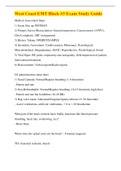West Coast EMT Block #3 Exam Study Guide
Medical Assessment Steps
1) Scene Size up: PENMAN
2) Primary Survey/Resuscitation: General impression, Consciousness (AVPU),
Chief complaint, ABC management
3) History Taking: OPQRST/SAMPLE
4) Secondary Assessment: Cardiovascular, Pulmonary, Neurological,
Musculoskeletal, Integumentary, GI/GU, Reproductive, Psychological, Social
5) Vital Signs: BP, pulse, respiratory rate and quality, field impression of patient,
interventions/treatment
6) Reassessment: Verbal reports/Radio reports
O2 administration cheat sheet
1) Nasal Cannula: Normal/Regular breathing (1-6 liters/min)
- Pattern and rate
2) Non-Rebreathable: Normal/Regular breathing (10-15 liters/min, high flow)
- Pattern and rate but borderline (10-20 RR)
3) Bag-valve mask: Abnormal/Irregular/Apneic/Absent (15-20 liters/min)
- Assist ventilations, artificial ventilations, > 8 or < 28 breaths/min
What part of the brain controls basic bodily functions like blood pressure,
breathing, heart rate, swallowing, etc)?
- Brain Stem
Where does the spinal cord exit the brain? - Foramen magnum
TIA (transient ischemic attack)
,- - A transient ischemic attack which are stroke-like symptoms that resolve on their
own in less than 24 hours.
- These symptoms occur when blood flow to the brain is obstructed either through
atherosclerosis (build-up of calcium and cholesterol in blood vessels) or blood
clotting (embolus)
Ischemic Stroke
- The most common type of strokes caused by a
- blockage of blood flow to a particular part of the brain usually by a blood clot
inside a blood vessel.
Two types of blood clot that may cause the blockage are:
- thrombosis (blood clot formed at the site of blockage) embolus (blood clot
formed elsewhere and travels to the site of blockage)
- atherosclerosis (calcium and cholesterol build up in the blood vessels).
Hemorrhagic Stroke
- - Occurs as a result of bleeding inside the brain.
- In this stroke the blood vessels ruptures and the accumulated blood then forms a
clot which compresses the brain tissue.
- The compression prevents oxygenated blood blood from getting into the area and
the brain cells begin to die. Often fatal.
- Commonly occurs in people experiencing stress or exertion, high blood pressure
or long term untreated elevated blood pressure.
Signs and Symptoms of a stroke - - Facial drooping
- Sudden weakness or numbness in the face, are, leg, or one side of the body
, - Lack of muscle coordination or no balance
- Sudden vision impairment
- Difficulty swallowing and tongue deviation
- Speech disorders (Aphasia)
- Dysarthria (slurred speech)
- Confusion, dizziness, weakness, restlessness
- Coma
How long should it take for a patient to come out of the postictal state? What is a
postictal state? - A postictal state is a period following a seizure in which the
seizure episode has ended and the patient starts to regain consciousness and lasts
from 5 to 30 minutes (sometimes more).
Know the risk factors for a seizure? - - Epileptic ----> Congenital origin
- Structural -----> Tumor, Infection, Head trauma, Strok
- Metabolic -----> Hypoxia, Abnormal blood chemical values, Hypoglycemia,
poisoning, Sudden withdrawal from drugs, alcohol, medication, etc.
- Febrile ----> Sudden high fever
What is a febrile seizure? - A seizure occurring from a sudden high fever
particularly in children.
What do we do for a patient who is having a seizure? What do we do once they
come out of the seizure? - - Maintain the ABCs
- Oxygen administration
- Call ALS
- Provide oral glucose for hypoglycemia according to the protocol




